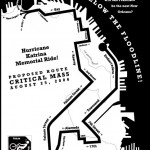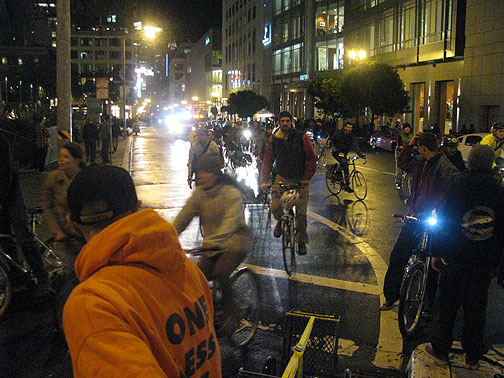
Art by Hugh D'Andrade
Has Critical Mass helped or hurt the bicycle cause in San Francisco? I asked some veteran bike activists for their view from the front lines. Dave Snyder, Mary Brown and Joel Pomerantz were key figures in the rise of bicycle advocacy in San Francisco. They each took the time to give their 2 cents.
As I noted last month, San Francisco has benefited over the last decade and a half from a resurgence of bicycling as a mainstream traffic option. Since 1992, when Critical Mass began, we have seen the following positive changes:
• More bikes on the road, increasing every year
• Massive and unprecedented increases in the membership of bike advocacy groups
• More funding for bike infrastructure
• Increasing respect from motorized traffic
Was Critical Mass a help or a hindrance to this positive change? To many, it is obvious that Critical Mass is hurtful, pointing to the anger it often inspires in motorists. Others, myself included, claim a net positive influence from this monthly ride, which after all was a major meeting place for the city’s bike-nerd intelligentsia — and in many cases inspired the very same individuals who were instrumental in making these changes a reality.
Many commentators wrote to remind me that my view lacks evidence (“correlation is not causation,” etc). And I respond by pointing out that the other side is equally lacking in evidence: the common view that Critical Mass has hurt the cause simply has no proof to back it up. None. There is no empirical evidence, that I know of, on either side of this argument.
Well, if empirical evidence is not available, we can find plenty of anecdotal evidence. I interviewed some of the bicycle activists that were involved in both mainstream bike advocacy and in Critical Mass. As you’ll see, some of what they say resonates with my argument, some of what they say negates it. You be the judge!
Did SFBC encourage Critical Mass? Was there much overlap in the two groups?
Dave Snyder, head of SFBC from 1991 to 2002, regular participant in Critical Mass since ride 1:
I think we were most helpful simply in not vilifying, criticizing, or opposing the ride. We tacitly approved of it, and listed it in our newsletter every month. We probably helped turnout a little bit, which might have been important but I think most of the outreach was more direct than through our newsletter, and we probably helped by just telling the mainstream bike crowd “this is OK.”
Do you think SFCM contributed to a boom in SFBC membership?
Dave Snyder: Slightly in the beginning. We would occasionally go to the events and sign people up. Then, with the crackdown [in 1997], our membership jumped about 50%. Huge! I personally thanked Willie Brown for our increase in membership.
Mary Brown, SFBC activist from 1996 to 2003 and regular Critical Mass participant:
Not directly. Early on (c.1996) Joel Pomerantz bought 100 or 500 subsidized memberships to SFBC and handed them out at Critical Mass. I remember that the renewal rates for those memberships were dismal. The real boom in membership only occurred in the last five years or so, and honestly I can’t figure out what precipitated such a tremendous increase in paid memberships. Likely the cumulative impact of many factors that’d been building for years.
Joel Pomerantz, founding newsletter editor for SFBC and co-founder of Critical Mass:
No impact. I handed out 20 to 40 memberships (Mary’s memory inflated it) and my memory is that it was hard to find people who really wanted them, and harder than I expected to find people who live in SF coming to Mass, at that time.
Do you think SFCM contributed to particular negotiations or bike projects?
Dave Snyder: In one instance, absolutely. It was during the huge explosion in CM and the crackdown in 1997. We asked for the city to “implement the bike network” which we agreed for the time being meant 8 key bike lane projects linking the city (2nd, 5th, Howard, Townsend, Polk, Arguello, Cesar Chavez, and 7th Avenue). The Mayor agreed to hearings on all 8, setting up a dynamic where we had to get something or else it would look really bad. We were careful to choose 8 projects which were not the easiest ones to implement. We eventually got bike lanes on 3-4 of the 8, hardly a resounding victory but more than we’d have gotten without CM, for sure, and setting us up for bigger success in the future. (As an aside, it’s worth pointing out that more than a decade later we’re still missing bike lanes on 2nd, 5th, and Cesar Chavez.)
Mary Brown: I doubt that CM currently has much of an impact on negotiations, but back in the day it was a large beast that loomed over various proposals for bike projects. It very clearly alerted decision-makers as to the existence of a large, unruly, and pissed constituency. Didn’t push any projects over the edge, but the general awareness of a large constituency was very helpful.
Joel Pomerantz: I’m sure policy-makers think about the looming monster of CM when they think of bikes, and the scary part is probably that they can’t fit it into their category system. It’s not a holiday, nor a parade, nor a demonstration, nor a sport. What is it? It’s not an organization or particular group of any kind. The police similarly have no easy way to fit it into their command and control system, but they probably understand the nature of it more than policy-makers who have never seen it’s many dimensions.
Was the net impact of SFCM on cycling issues helpful or a hindrance during your tenure?
Dave Snyder: Absolutely helpful. Not perfectly helpful, but, you asked about the net impact and undeniably it was great.
Mary Brown: Net impact? Helpful, absolutely. But it’s important to note that the people doing the actual nitty-gritty organizing around specific bike lanes/proposals, (i.e., presenting at neighborhood meetings, lobbying the BoS, building support from seniors, pedestrians, etc.) often had the hassle and image of CM thrown back at them. There is and always have been a fluctuating backlash against CM.
Joel Pomerantz: I’d say, if Critical Mass is good for bicycling, it’s mostly because it helps define a culture, which imparts strength to that culture. But that’s not empirical. If it’s bad for bicycling, then there must be a lot of other things hiding in the alleys that are really great for bicycling, because something is making cycling pick up incredible popularity. I guess that’s part of your metrics argument, eh? That’s not empirical, either. More excellent evidence that Mass has helped is that it spreads, keeps changing, and has never been overtaken by aggression — at least not when compared to car driving, which seems to turn calm folks into raging lunatics.
Any thoughts on SFCM at present? Has it outlived its usefulness?
Dave Snyder: Hell no it hasn’t outlived its usefulness. For me, it’s not that fun any more for a variety of reasons, and I think that it needs a bit of a reinvention or rejuvenation to achieve a better role in city life, but it’s still a chance for people to bike in a crowd feeling safe the way they don’t or can’t on the streets typically. And it still gives a glimpse of what the street could be like. But it’s worth pointing out that there are other events like that now that didn’t exist when we started Critical Mass, like Sunday Streets (or Open Streets as folks around the country are trying to rename it). I don’t think it’s that useful to mainstream bicycle advocacy as it was in the mid-90s, but that was never its main reason for existence anyway.
Mary Brown: CM used to be at the center of my social calendar, but for me personally, it got boring. I was having the same experience over and over — a fun, oft-exhilarating experience, but the sameness got to me. And I got sick of the confrontations. When I do go to CM (usually just on Halloween) I’m thrilled to see how many new riders have claimed it as their own. Riders that were in junior high during what I think of as the golden age of Critical Mass. It’s honestly also weird to barely know anyone at Critical Mass, whereas, in the 1990s I knew or recognized a large percentage of riders. Despite its professed lack of organization, back in the day, it was organized by a loose confederation of CMers. A great deal of thought and care went into creating a positive, corked ride with thoughtful missives. Not sure where that’s at today.
If you have evidence, empirical, anecdotal — or chemical for that matter — that argues one way or another on this point, I would love to hear it. Please share your thoughts! Thanks!



